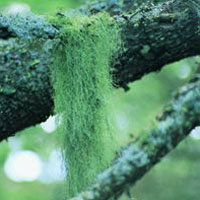Usnea
Uses
Parts Used & Where Grown
Usnea, also known as old man’s beard, is not a plant but a lichen—a symbiotic relationship between an algae and a fungus. The entire lichen is used medicinally. Usnea looks like long, fuzzy strings hanging from trees in the forests of North America and Europe, where it grows.
Our proprietary “Star-Rating” system was developed to help you easily understand the amount of scientific support behind each supplement in relation to a specific health condition. While there is no way to predict whether a vitamin, mineral, or herb will successfully treat or prevent associated health conditions, our unique ratings tell you how well these supplements are understood by the medical community, and whether studies have found them to be effective for other people.
For over a decade, our team has combed through thousands of research articles published in reputable journals. To help you make educated decisions, and to better understand controversial or confusing supplements, our medical experts have digested the science into these three easy-to-follow ratings. We hope this provides you with a helpful resource to make informed decisions towards your health and well-being.
3 Stars Reliable and relatively consistent scientific data showing a substantial health benefit.
2 Stars Contradictory, insufficient, or preliminary studies suggesting a health benefit or minimal health benefit.
1 Star For an herb, supported by traditional use but minimal or no scientific evidence. For a supplement, little scientific support.
This supplement has been used in connection with the following health conditions:
| Used for | Why |
|---|---|
|
1 Star
Common Cold and Sore Throat
Refer to label instructions
|
Usnea has a traditional reputation as an antiseptic and is sometimes used for people with common colds.
Elderberry has shown antiviral activity and thus may be useful for some people with common colds. Elder flowers are a traditional diaphoretic remedy for helping to break fevers and promote sweating during a cold. Horseradish has antibiotic properties, which may account for its usefulness in easing throat and upper respiratory tract infections. The resin of the herb myrrh has been shown to kill various microbes and to stimulate macrophages (a type of white blood cell). has a traditional reputation as an antiseptic and is sometimes used for people with common colds. |
|
1 Star
Cough
Refer to label instructions
|
Usnea contains mucilage, which may be helpful in easing irritating coughs.
The mucilage of slippery elm gives it a soothing effect for coughs. also contains mucilage, which may be helpful in easing irritating coughs. There is a long tradition of using wild cherry syrups to treat coughs. Other traditional remedies to relieve coughs include bloodroot, catnip, comfrey (the above-ground parts, not the root), horehound, elecampane, mullein, lobelia, hyssop, licorice, mallow, (Malvia sylvestris),red clover, ivy leaf, pennyroyal (Hedeoma pulegioides, Mentha pulegium),onion, (Allium cepa), and plantain (Plantago lanceolata, P. major). None of these has been investigated in human trials, so their true efficacy for relieving coughs is unknown. |
|
1 Star
Infection
Refer to label instructions
|
Usnea is an herb that directly attack microbes.
Herbs that directly attack microbes include the following: chaparral, eucalyptus, garlic, green tea, lemon balm (antiviral), lomatium, myrrh, olive leaf, onion, oregano, pau d’arco (antifungal), rosemary, sage, sandalwood, St. John’s wort, tea tree oil, thyme, and . |
Traditional Use (May Not Be Supported by Scientific Studies)
Due to its bitter taste, usnea stimulates digestion and was historically used by herbalists to treat indigestion. It was also reportedly used over 3,000 years ago in ancient Egypt, Greece, and China to treat unspecified infections.1
How It Works
How It Works
Usnic acid gives usnea its bitter taste and also acts as an antibiotic in test tube studies.2 Test tube studies have suggested an anti-cancer activity for usnic acid. However, this action has not been sufficient to warrant further investigation in humans.3 Usnea also contains mucilage, which may be helpful in easing irritating coughs. Again, this has not been studied in humans.
How to Use It
Usnea, 100 mg three times per day, can be taken in capsules.4 Tincture, 3–4 ml three times per day, can also be used.
Interactions
Interactions with Supplements, Foods, & Other Compounds
Interactions with Medicines
Side Effects
Side Effects
There are no known side effects of usnea. It is considered safe for use in children. The safety of usnea during pregnancy and breast-feeding has not been established.
References
1. Tilford GL. Edible and Medicinal Plants of the West. Missoula, MT: Mountain Press Publishing Company, 1997, 148-9.
2. Weiss RF. Herbal Medicine. Beaconsfield, UK: Beaconsfield Publishers Ltd., 1988, 49.
3. Evans WC. Trease and Evans' Pharmacognosy, 13th ed. London: Baillière Tindall, 1989, 643.
4. Gruenwald J, Brendler T, Jaenicke C, et al. (eds). PDR for Herbal Medicines. Montvale, NJ: Medical Economics, 1998, 1199-200.
Last Review: 04-28-2015

Copyright © 2025 TraceGains, Inc. All rights reserved.
Learn more about TraceGains, the company.
The information presented by TraceGains is for informational purposes only. It is based on scientific studies (human, animal, or in vitro), clinical experience, or traditional usage as cited in each article. The results reported may not necessarily occur in all individuals. For many of the conditions discussed, treatment with prescription or over the counter medication is also available. Consult your doctor, practitioner, and/or pharmacist for any health problem and before using any supplements or before making any changes in prescribed medications. Information expires December 2025.



